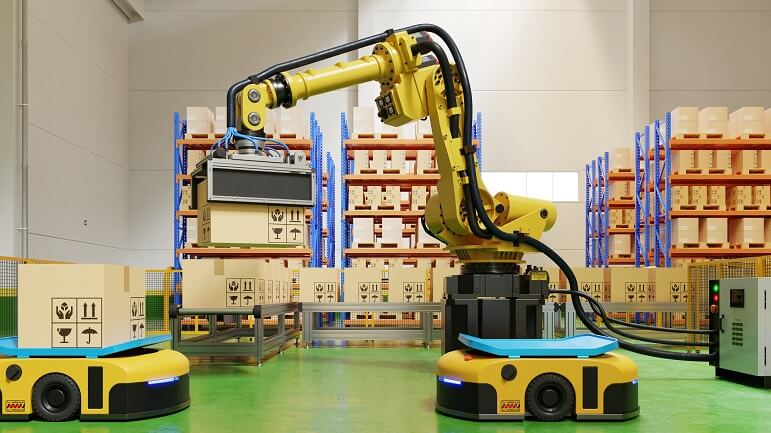5 Benefits of artificial intelligence in supply chain management
As global supply chains become more complex, disruption in one link can significantly impact other areas. Therefore, it is essential to have systems and processes to reduce the possibility and impact of supply chain issues.
While advancing technologies, like artificial intelligence (AI) and machine learning (ML), used to be expensive, costs are falling significantly. This means even the smallest companies can take advantage of them to make connectivity and supply chain visibility easier. Therefore, more businesses are using them to prevent and overcome inventory management challenges, gain a competitive advantage, and meet customer demand.
What is artificial intelligence?
Artificial intelligence simulates human intelligence processes so that computers or robots can carry out tasks usually done by humans.
AI was once only seen in science fiction. However, it is now common in everyday life. For example, navigation apps, facial recognition, smart assistants, and even robot vacuum cleaners at home use this smart tech.
AI-enabled technology is revolutionizing business operations to help make cost-effective, data-driven strategic decisions faster than ever before.
Inventory management AI solutions can adapt in real-time to changing conditions. This enables them to develop new knowledge by processing more data and revealing more patterns and trends than humans or traditional algorithms can.
To optimize supply chain operations, this could include generating demand forecasts to ensure stock availability mapping transportation routes to prevent idle time and reduce fuel consumption.
What is machine learning?
Machine learning (ML) is a subset of artificial intelligence. It uses algorithms, software, or systems to learn how to solve a problem without specifically being programmed in how to do it. ML models teach themselves over time by analyzing trends, spotting anomalies, and offering predictive insights.
Using regularly gathered data, it notices patterns and suggests actions. This could include working out shorter warehouse picking routes, predicting upcoming faults in warehouse automation machinery to prevent breakdowns or tracking packages across their entire supply chain journey to optimize the route and ensures timely deliveries.
Machine learning can also highlight areas for improvement that a human might miss or take longer to identify. This helps deal with potential issues before they arise and reduces the chance of future problems.

A subset of ML that is being heavily focused on at present is large language models (LLMs). The most popular use of LLMs is generative AI platforms like ChatGPT and Google Bard.
Systems like ChatGPT have been trained on millions of examples of content across the internet to learn how characters, words, and sentences interact. You can ask an LLM system a question, and it will reply using this data without human interaction.
Many software systems now incorporate generative AI systems to support customer service and chatbots. For example, social media management tools can draft posts from a simple prompt, and companies can operate self-service help desks and chatbots with extensive answer possibilities. This allows customer support teams to focus on more complex issues, but interact where necessary.
Benefits of artificial intelligence and machine learning in supply chain management
Intelligent, autonomous warehouse technology is already positively impacting warehouses worldwide. You can read about warehouse automation and technology in our article, where we discuss voice technology, radio frequency identification, automated guided vehicles, and robots.
Here are some benefits of combining machine learning with advanced analytics and real-time monitoring to get complete visibility across the supply chain.
Inventory management and AI
Efficient inventory management is fundamental to business success. Inventory management teams struggling to calculate healthy stock levels without over- or under-stocking will know the challenges this brings.
Standard inventory management software only has basic inventory management functionality. It relies on a lot of manual interaction, which is time-consuming and increases the risk of human error. As it cannot track the product lifecycle or classify stock, and doesn’t have advanced algorithms, forecasting will be little more than a best guess. Without a real understanding of historical and future demand trends, you’ll face costly stockouts and overstocking. This is why AI has become integral to inventory management: to increase efficiency, ensure stock availability, minimize costs, and keep customers happy.
Using algorithms, AI provides better quality data, making analysis easier and giving a complete overview of your warehouse and supply chain. With the ability to run different scenarios, AI and ML can provide information about the optimal stock levels to meet predicted sales forecasts.
As the analysis is carried out daily, you will be prompted where to change your strategy to respond to rapidly changing market situations. For example, adjusting the speed and volume of order processing to meet demand. This level of understanding and predictive analytics drives intelligent and informed strategic decisions to reduce inventory and operating costs and propel business growth.
AI and demand forecasting
Accurate demand forecasting is essential in supply chain management. It helps set optimal inventory levels, reducing holding costs while improving stock availability.
Rather than reviewing only historical sales and demand data, machine-learning-powered forecasting solutions can quickly analyze large datasets to identify patterns. They can also analyze external factors to reduce the risk of overstocking or stockouts and highlight emerging issues and threats in the supply chain before they disrupt the business.
Implementing preventative measures will increase supply chain resilience, bring more effective results and reduce the negative impact on the business.

Machine learning and increased efficiency
Manual, paper-based processes are incredibly time-consuming and risk human error. Automating these processes will save admin time and reduce costs. It will also give your supply chain and inventory managers more time to focus on strategic activities.
Machine-learning models can be trained to help identify possible areas of inefficiency and waste. Then, you can use recommendations to create a more flexible environment for effectively dealing with disruption.
AI- and ML-enabled machines can reduce operator error and processing times, increasing efficiency and productivity. For example, by calculating the number of pallets that need moving and the subsequent equipment and labor required, you can ensure optimal efficiency in the warehouse.
Machine learning can transform warehouse management by handling repetitive tasks. A more efficient warehouse can reduce overheads and highlight improvement opportunities.
Combining technology with human operatives will speed up monotonous and time-consuming activities, providing more time for tasks only humans can do. For example, machine-learned computers can provide information to support packing shipments and organizing products. As the warehouse team scans shipments in the warehouse, the computers track your inventory accurately.
Machine learning algorithms can analyze large data sets to detect potential defects or damage in warehouse equipment or stock. They can provide early insight into the cause of the problem, meaning it can be resolved quickly before it impacts the business. This reduces the chance of equipment breaking down or sending faulty goods to customers.
Integrating machines into warehouse processes can also improve warehouse safety. Using AI robots to drive dangerous machinery and store inventory in hard-to-reach places reduces the risk of accidents. If an accident does happen, the possibility of human injury is significantly reduced.
Our article has more information about warehouse automation and technology, and discusses voice technology, radio frequency identification, automated guided vehicles, and robots.
Managing suppliers with AI and ML
Any supplier problems will impact your ability to meet demand.
Machine learning and artificial intelligence can offer valuable insights into supplier performance, such as product failures or missed deliveries.
The software can run different supplier scenarios based on lead times, prices or other parameters to help make real-time, strategic decisions. You can then choose the best supplier to meet your order needs.
You can also adapt large language models like ChatGPT, which we discussed above, to manage dialogue with your suppliers. This can take care of regular communications and highlight the exceptional ones that need your attention.
Improved customer service
With AI-powered systems ensuring you have the right stock, you can ensure customers receive their orders when they need them. This increases customer satisfaction and loyalty in a competitive market to support business growth.
Machine learning techniques can improve supply chain visibility and help businesses follow orders from shipment to delivery. Real-time data allows for a better customer experience, as you can provide more accurate delivery information.
While customers still need human interaction, machine learning can support the customer service team. For example, for improved customer satisfaction, support chats on websites or AI-enabled help assistants allow people to find quick answers, filtering to a helpline if necessary.
Inventory optimization software
An AI-powered inventory optimization system like EazyStock is a powerful tool that can be connected to enterprise resource planning, business systems, and advanced warehouse management systems.
By classifying your inventory, EazyStock’s machine-learning-enriched forecasting improves forecast accuracy and predicts customer demand by analyzing historical sales data, real-time inventory data and market trends. Its machine-learning algorithms generate accurate demand forecasts that consider trends, seasonality, and product lifecycle profiles.
These advanced analytics provide a comprehensive view of demand patterns and enhance visualisation.
EazyStock automates everyday inventory calculations, including reorder points, order quantities, and safety stock levels. It also provides optimized order proposals that feed back to your stock ordering system and are ready for purchasing.
Using EazyStock, you can classify inventory items, set dynamic stocking policies, and adjust stock levels based on moving factors, including forecasts, demand profiles, and supplier lead times.
Speak to one of our experts to learn how EazyStock can AI enable your business to elevate your inventory management processes and help you make data-driven decisions, leaving more time to focus on your strategic business goals.









